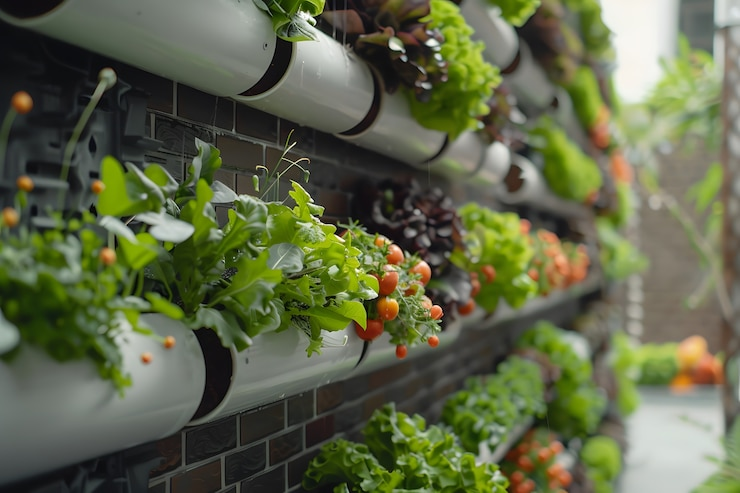SEARCH
RECENT POSTS
Categories
- Agriculture (27)
- Automobiles (18)
- Banking and Financial services (31)
- Consumer Markets (44)
- Defence (6)
- Ecommerce (19)
- Economy (66)
- Education (12)
- Engineering (6)
- Exports (21)
- Healthcare (23)
- India Inc. (7)
- Infrastructure (29)
- Manufacturing (24)
- Media and Entertainment (12)
- Micro, Small & Medium Enterprises (MSMEs) (15)
- Miscellaneous (30)
- Perspectives from India (33)
- Pharmaceuticals (3)
- Railways (4)
- Real Estate (16)
- Renewable Energy (17)
- Research and Development (8)
- Retail (1)
- Services (6)
- Startups (15)
- Technology (53)
- Textiles (6)
- Tourism (11)
- Trade (5)
How Urban Farming is Gaining Ground in India’s Metro Cities

- Sep 26, 2025, 18:15
- Agriculture
- IBEF
In India’s sprawling metro hubs, a quiet revolution is taking root. Urban farming—growing food within city boundaries—is blending garden greens with concrete greys, promising fresh produce alongside environmental benefits. With India’s urban population numbering ~53,49,16,498 (2024) and rising, these initiatives are hardly a fad; they are a necessity for resilient, sustainable cities. City gardens minimise transport costs, shrink carbon footprints, and bring nutritious food directly to doorsteps. In effect, tomorrow’s megacities could become food producers themselves, helping feed citizens locally. Globally, the trend is clear: more than half the world now lives in cities, and 68% of humanity is expected to be urban by 2050. This means cities will consume the bulk of the world’s food. As primary food consumers, cities must increasingly shoulder the responsibility of growing their own food. In this light, urban farming is not just a trend but a vital strategy for food security and sustainability.
The urban food imperative
Rapid urban growth puts tremendous stress on food supply chains. Long transport routes and centralised distribution make city dwellers vulnerable to disruptions from pandemics, climate shocks or logistical breakdowns. Urban farming directly addresses this; city-grown vegetables and fruits offer a local buffer. Studies highlight that urban farms are crucial to food security by ensuring “a steady supply of locally grown fresh produce,” reducing dependency on distant regions and building resilience during crises. For example, rooftop and backyard gardens can provide a steady trickle of greens even if rural supplies falter.

Taken together, these advantages make urban farming more than just a sustainable food trend. In fact, it has become a necessity for thriving cities.
Hyperlocal and hyperconnected: The global urban farming landscape
The global embrace of urban farming is also fuelling a booming industry. Valued at around Rs. 18,64,541 crore (US$ 219.10 billion) in 2023, the urban agriculture market is projected to reach Rs. 23,98,118 crore (US$ 281.80 billion) by 2030 growing at ~3.1% annually. This booming market underscores the economic potential of turning cities into farms, alongside the environmental and social gains.
Cities worldwide are experimenting in parallel, and ideas are flowing across borders. From New York to Tokyo, innovators are turning steel and glass into soil beds. For example, Bowery Farming in New York City and Tokyo’s Pasona Urban Farm have built vertical farming towers and community farmlands right in the urban core. Paris boasts Nature Urbaine, one of Europe’s largest rooftop farms, and Shanghai has dedicated entire districts (Sunqiao) to high-tech agriculture. Notably, Singapore’s recent urban farms now supply about 90% of the city-state’s leafy greens.
In contrast to the technology-driven approaches seen in other parts of Asia, India’s urban farming is community-driven and focuses on achieving food self-sufficiency.
Projects like the Mumbai Port Trust Garden convert unused urban spaces into flourishing community gardens. These projects are often supported by non-governmental organisations and often employ women, providing them with social and economic benefits.
Green in the grey: India’s metro cities take root
Back home, India’s metros are transforming grey spaces into greenery. In Mumbai, Delhi and Bengaluru, under-used rooftops and vacant lots are being converted into vegetable plots and community gardens. Chennai and Hyderabad are experimenting with rooftop greenhouses and high-tech hydroponic farms to boost local produce. Even government policy is sowing the seeds for city farming: India’s National Urban Livelihoods Mission (NULM) explicitly promotes urban agriculture as sustainable employment, and smart-city plans are earmarking parks and public spaces for edible landscaping. Subsidies for rainwater-harvesting planter boxes and urban compost projects are under discussion in states.
These grassroots efforts are timely. Today, India’s cities are home to ~534.9 million people—around 35% of the population—and this number is growing fast. India is poised to have the world’s largest population (and urban population) in the coming years. Hence, its cities stand to play a significant role in feeding the nation. By allocating even a fraction of city land to farming, local governments can strengthen food access and cut out the pollution from long-haul food transport. Even converting 5–10% of a city’s area (parks, rooftops, public spaces) into gardens could yield a large chunk of its vegetables. In short, India’s concrete is gradually going green, one balcony or community plot at a time.
Not just food, a new urban ethos
Urban farming is reshaping city life in unexpected ways. It is not merely about food production but about reconnecting people with nature and each other. Researchers note that cultivating food in cities can restore and strengthen human-nature relationships and improve well-being. Planners and social groups are seizing on this. For example, the UP-AGrI project (Urban and Peri-Urban Agriculture as Green Infrastructure) lays out ways to weave farming into the fabric of city life:

Communities are already embracing these ideas. In Bengaluru, for instance, a Non-Governmental Organization (NGO) runs a weekly “Green Sunday” where city volunteers of all ages plant and tend neighbourhood vegetable beds. Likewise, even the city’s sanitation workers are recognised as stewards of this change: activists note that garbage collectors often “have the skills of both gardening and composting,” that can be upscaled with proper training. As one local urban-farming entrepreneur puts it, we must “distinguish between urban food production and large-scale agriculture” and build the right skills. In short, a new urban ethos is emerging – one where growing food in the city is seen as a shared responsibility and community activity, not just a hobby.
Technologies fuelling the movement
Modern technology is supercharging urban farming. From apps to aeroponics, these innovations help cities squeeze high yields out of tiny spaces. Key advances include:
- Mobile co-farming platforms: New apps let citizens lease and manage plots remotely. For example, Bengaluru residents can use the Farmizen platform to rent a 600 sq. ft suburban plot; farmworkers tend it on their behalf so users can quickly visit and harvest fresh organic produce whenever they want. Such “farm-by-wire” models expand participation even for people without any land.
- Soilless cultivation: Hydroponic and aeroponic systems grow crops with minimal water and space. Indoor farms like AeroFarms in the US and Agricool’s converted shipping containers in Paris use nutrient-rich mist and LED lighting to yield vegetables year-round. They can use up to 90% less water than field farming and can be set up on any urban rooftop or vacant warehouse. Similarly, Singapore’s Sustenir and others grow leafy greens on tech-driven vertical racks, turning city buildings into mini-farms.
- Aquaponics: Some city farms integrate fish and plants in closed loops. London’s GrowUp Urban Farms, for example, uses aquaponics: fish waste fertilizes the plants, and in turn the plants purify the water for the fish. This allows urbanites to turn a former brownfield into a productive fish-and-vegetable farm, maximising efficiency on limited land.
- Smart farming & data: Even small gardens benefit from sensors and software. Smartphone apps now help urban growers map soil moisture, light, and weather data for each plot, optimising watering, and planting schedules. In India and abroad, precision-farming tools mean that even amateur urban farmers can get farm-quality guidance to boost yields.
Indian innovators are part of this tech wave. A host of startups like Barton Breeze, Clover Ventures, Homecrop, Growing Greens, etc. are adapting greenhouse and vertical-farm techniques to local conditions. These ventures often partner with research institutes to refine microclimate farming for India’s heat and light. The result is a fast-growing urban agricultural toolkit, from soil sensors to LED-lit towers, bringing high-tech yields to metro rooftops.
Community and inclusion at the core
Crucially, urban farming is proving to be an inclusive social force. It creates access and agency for many who are otherwise left out of the food system. Grassroots projects are springing up in slums, schools, and housing societies. Women’s self-help groups and youth clubs are learning to grow sprouts on apartments’ fire staircases and sharing harvests with neighbours. In Bengaluru’s case, NGOs emphasise local involvement. For example, one noted that even city sweeper crews are gardeners with compost skills. Programs ensure that the poorest have a stake in the gardens, and not just the affluent with private terraces.
Community volunteers are key drivers. Every weekend Bengaluru’s “Green Sunday” event sees scores of families and students converging on public plots to plant vegetables. Such gatherings build social cohesion around farming. Citizens also pressure officials. As one entrepreneur warns, urban farming needs new skills and must be treated differently from rural agriculture. This has resonated – for example, training institutes are beginning to offer courses in terrace gardening and vermicomposting, aimed at urban residents. In short, city agriculture is by and for the people: it brings neighbours together, educates children in sustainability, and opens paths to green livelihoods. Everyone from techies to waste-pickers is finding a role in this ecosystem.
The potential payoff is huge. Research suggests that if fully adopted, city farming worldwide could yield ~180 million tons of vegetables and tubers annually – 10% of global output for those crops. The journey ahead is about partnership: between citizens, scientists, entrepreneurs, and officials. With smart policies and community drive, India’s urban centers can become cities that feed themselves. The payoffs are multiple – from cleaner air and shaded neighbourhoods to empowered livelihoods and abundant vegetables – heralding a greener, healthier ethos for city life. By turning even concrete rooftops and courtyards into gardens, our metro areas could transform into living ecosystems that nourish the people and planet together.
















